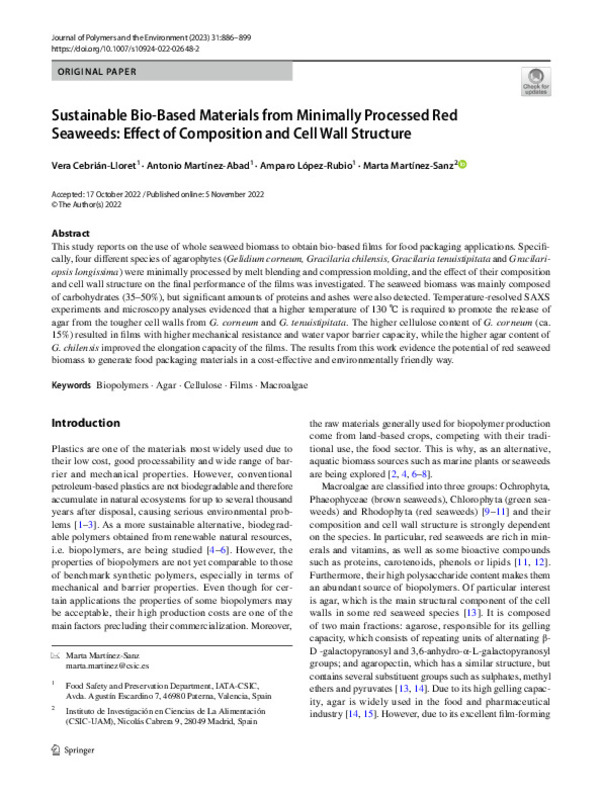JavaScript is disabled for your browser. Some features of this site may not work without it.
Buscar en RiuNet
Listar
Mi cuenta
Estadísticas
Ayuda RiuNet
Admin. UPV
Sustainable Bio-Based Materials from Minimally Processed Red Seaweeds: Effect of Composition and Cell Wall Structure
Mostrar el registro sencillo del ítem
Ficheros en el ítem
| dc.contributor.author | Cebrián-Lloret, Vera
|
es_ES |
| dc.contributor.author | Martínez-Abad, Antonio
|
es_ES |
| dc.contributor.author | López-Rubio, Amparo
|
es_ES |
| dc.contributor.author | Martínez-Sanz, Marta
|
es_ES |
| dc.date.accessioned | 2024-01-26T19:02:13Z | |
| dc.date.available | 2024-01-26T19:02:13Z | |
| dc.date.issued | 2023-03 | es_ES |
| dc.identifier.issn | 1566-2543 | es_ES |
| dc.identifier.uri | http://hdl.handle.net/10251/202174 | |
| dc.description.abstract | [EN] This study reports on the use of whole seaweed biomass to obtain bio-based films for food packaging applications. Specifically, four different species of agarophytes (Gelidium corneum, Gracilaria chilensis, Gracilaria tenuistipitata and Gracilariopsis longissima) were minimally processed by melt blending and compression molding, and the effect of their composition and cell wall structure on the final performance of the films was investigated. The seaweed biomass was mainly composed of carbohydrates (35-50%), but significant amounts of proteins and ashes were also detected. Temperature-resolved SAXS experiments and microscopy analyses evidenced that a higher temperature of 130 celcius is required to promote the release of agar from the tougher cell walls from G. corneum and G. tenuistipitata. The higher cellulose content of G. corneum (ca. 15%) resulted in films with higher mechanical resistance and water vapor barrier capacity, while the higher agar content of G. chilensis improved the elongation capacity of the films. The results from this work evidence the potential of red seaweed biomass to generate food packaging materials in a cost-effective and environmentally friendly way. | es_ES |
| dc.description.sponsorship | Open Access funding provided thanks to the CRUE-CSIC agreement with Springer Nature. This work was financially supported by Hispanagar. Synchrotron experiments were performed at NCD beamline at ALBA Synchrotron with the collaboration of ALBA staff (2020024090 project). | es_ES |
| dc.language | Inglés | es_ES |
| dc.publisher | Springer-Verlag | es_ES |
| dc.relation.ispartof | Journal of Polymers and the Environment | es_ES |
| dc.rights | Reconocimiento (by) | es_ES |
| dc.subject | Biopolymers | es_ES |
| dc.subject | Agar | es_ES |
| dc.subject | Cellulose | es_ES |
| dc.subject | Films | es_ES |
| dc.subject | Macroalgae | es_ES |
| dc.title | Sustainable Bio-Based Materials from Minimally Processed Red Seaweeds: Effect of Composition and Cell Wall Structure | es_ES |
| dc.type | Artículo | es_ES |
| dc.identifier.doi | 10.1007/s10924-022-02648-2 | es_ES |
| dc.relation.projectID | info:eu-repo/grantAgreement/ALBA Synchrotron Light Source//2020024090/ | es_ES |
| dc.rights.accessRights | Abierto | es_ES |
| dc.description.bibliographicCitation | Cebrián-Lloret, V.; Martínez-Abad, A.; López-Rubio, A.; Martínez-Sanz, M. (2023). Sustainable Bio-Based Materials from Minimally Processed Red Seaweeds: Effect of Composition and Cell Wall Structure. Journal of Polymers and the Environment. 31(3):886-899. https://doi.org/10.1007/s10924-022-02648-2 | es_ES |
| dc.description.accrualMethod | S | es_ES |
| dc.relation.publisherversion | https://doi.org/10.1007/s10924-022-02648-2 | es_ES |
| dc.description.upvformatpinicio | 886 | es_ES |
| dc.description.upvformatpfin | 899 | es_ES |
| dc.type.version | info:eu-repo/semantics/publishedVersion | es_ES |
| dc.description.volume | 31 | es_ES |
| dc.description.issue | 3 | es_ES |
| dc.relation.pasarela | S\499313 | es_ES |
| dc.contributor.funder | Hispanagar, S.A. | es_ES |
| dc.contributor.funder | ALBA Synchrotron Light Source | es_ES |








